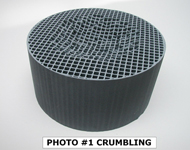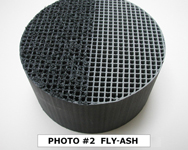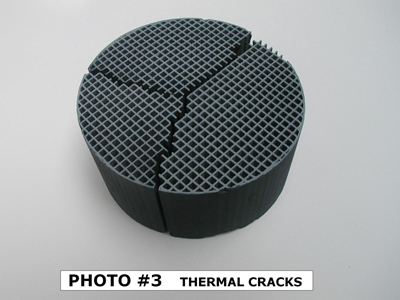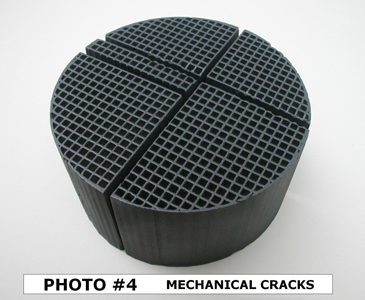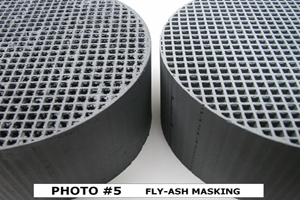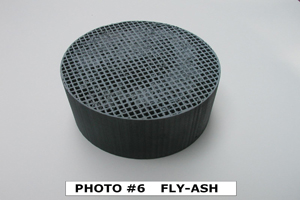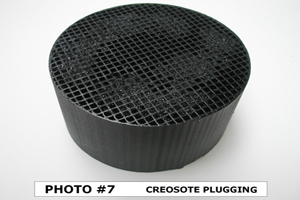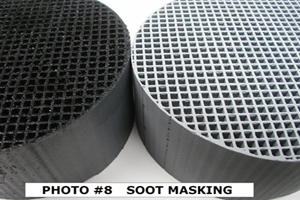FireCat Catalytic Combustors Frequently Asked Questions
This section was created in a effort to assist you with questions and answers to some common queries about catalytic woodstoves and catalytic combustors.
Contents
 Click topic for quick navigation. Click topic for quick navigation.
What is a catalytic combustor?
Our catalytic combustors consist of a durable, temperature-resistant ceramic composition which is extruded into a specific cell density, creating a honeycomb configuration. It is then cut to manufacturer's specified sizes and fired. We then wash coat the unit with alumina oxide for high surface area coating and precious metal support. Later a noble-metal catalyst, like Palladium is applied.
Origin of the Woodstove Combustor
Understanding catalytic’s role in the wood burning stove industry, requires us to look back to the 1970’s when heating costs increased drastically. Oil
prices increased 272% in that decade, electric rates increased 215%, while natural gas increased 483%. To combat these cost increases, many homeowners
began to switch to wood as a fuel for their heating needs. This was less costly and besides firewood was free and plentiful in many areas.
Hundreds of new stove companies began to spring up. Many of them building stoves with efficiency between 50 and 70%. This was as good as or better than gas
furnaces and oil burners. However, the advantages of burning wood for heating was also accompanied with some disadvantages.
- Much wasted energy was lost in the smoke (30% in some stoves).
- The smoke from wood-burning fires produced harmful air pollution
- Airtight stoves burning slow produced heavy amounts of Creosote.
It was in the early 1980’s that the catalytic combustor was found to be an ideal solution aimed at answering consumer, manufacturing and environmental problems.
The U.S. EPA and DEQ later set standards for the stove manufacturers to follow and a new era in wood burning began. Applied Ceramic’s role in the industry’s progress
was important back then and still is today. We are the world’s largest manufacturer of catalytic combustors for wood burning stoves.

NOTE: CATALYTIC WOOD STOVES ARE DESIGNED TO BURN NATURAL, SEASONED DRY WOOD ONLY
Return to top
How does a Firecat™ catalytic combustor work?
Five to thirty percent of the chemical energy contained in every log escapes up the chimney when the wood is burned in a conventional airtight stove. Our catalytic combustors are designed to make use of this energy, converting it into useful heat as it lessens chimney creosote build up and air pollution. When wood smoke contacts this catalyst, chemical changes occur that cause the smoke to ignite at temperatures around 500°F (260°C) - temperatures easily found in a wood-stove firebox. Normally, smoke will ignite and burn only at temperatures around 1000°F (540°C) It is important to make sure the catalytic combustor has achieved light-off before closing the stoves bypass damper. In general, the catalytic combustors needs 500°F (260°C) focused on it for 20 to 30 minutes to achieve light-off when initially building a fire in your stove. The bypass damper can then be closed directing the gases through the combustor . At this point the exhaust temperature of the combustor will rise to a range between 1000°F to 1600°F indicating the smoke is burning. 1200° to 1400°F (650-760°C) should be maintained as the operating temperature of the catalytic combustor.
By definition, a catalyst is not consumed or used up. The nature of a catalytic reaction is often defined as:
"A substance, usually present in small amounts related to the reactants, that modifies and especially increases the rate of a chemical reaction without being consumed in the process."
Normally, smoke will burn, or oxidize, at a temperature of 10,000°F or higher. Burning a stove this hot would require continuous intense fire and would require a higher wood consumption. The answer to eliminate this is the catalytic combustor.
Wood smoke gases coming in contact with the catalyst causes chemical changes to take place. This will then allow the smoke to ignite at temperatures around 5000°F (or 2600°C). This temperature is easily achieved in the firebox of a wood burning stove. As the gases ignite and burn within the catalytic combustor, clean by-products of water vapor (H20) and carbon dioxide (C0²) are emitted.
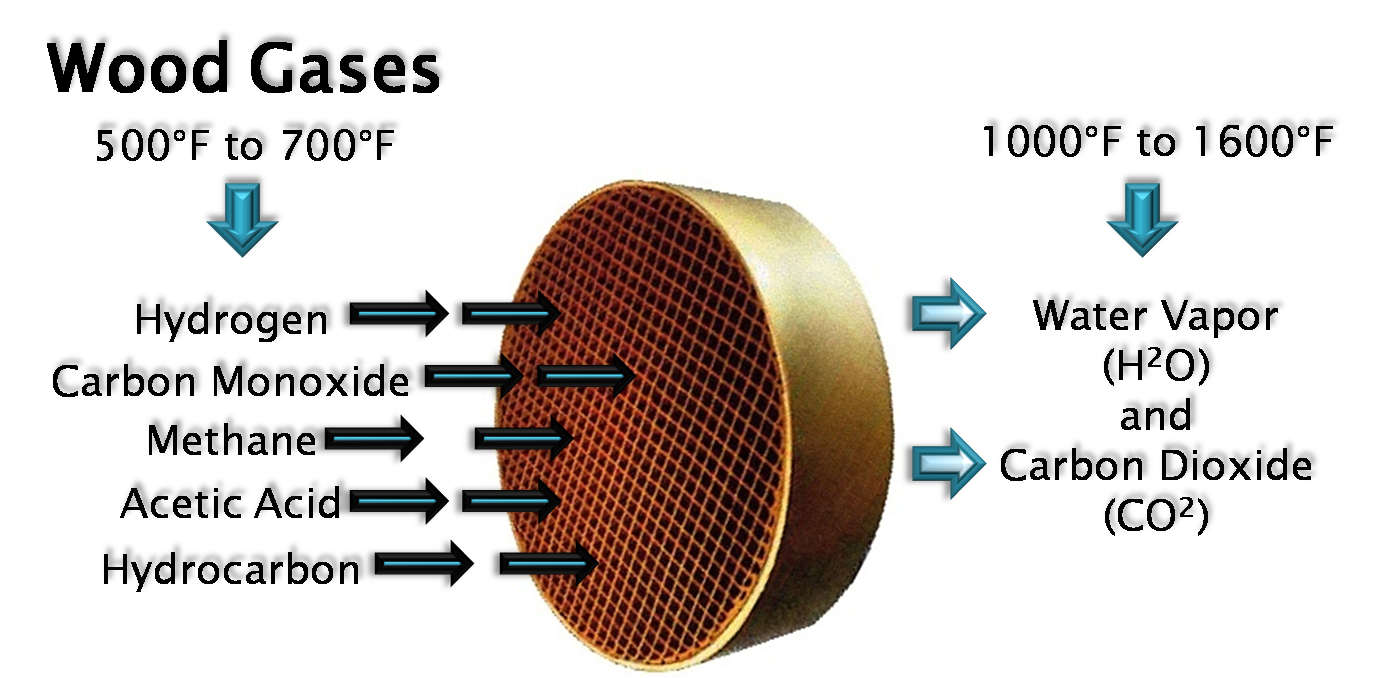
What are Catalytic Combustors Made Of?
Most catalytic combustors used in manufacturing catalytic stoves today are made of a high temperature, honeycomb patterned ceramic substrate. They are coated with special noble metals like palladium and/or platinum. The honeycomb pattern gives the combustor surface area for the catalytic coatings.

What does a catalytic combustor do in a wood burning stove?
Complete combustion or burning the smoke from a wood fueled fire ordinarily requires temperatures too high to be practical in a wood stove. However, as smoke passes through the catalytic combustor, it comes in contact with a noble metal coating which is adhered to the honeycomb shaped ceramic base and reduces the temperature at which the smoke will burn. The smoke ignites at this lower temperature and then burns efficiently to produce additional heat from every log. Thus, the stove becomes more efficient and requires fewer cords of wood. In other words, as the Firecat™ catalytic combustor burns smoke within the wood stove, it creates additional heat. In fact, independent research has shown that up to 50% more heat is generated from each piece of wood. This means savings to the owner because compared to costs for natural gas, heating oil and electricity, wood heat is an excellent value.
What advantages are provided by a Firecat™ combustor?
90% LESS POLLUTION* - Gases and particles in smoke cause air pollution. The combustor eliminates 90% of this pollution by burning these gases and particles before they exit the stove.
90% LESS CREOSOTE* - Condensation of smoke in chimneys and flues creates creosote build up which is the primary cause of chimney fires. The combustor reduces this danger because it burns most of the smoke and reduces creosote accumulation as much as 90%. However, you should continue to inspect your chimney regularly for safety.
* Performance may vary depending on stove design, operation and combustor age.
How do I maintain the combustor's operating condition?
During the start-up of a cold stove, a medium to high firing rate must be maintained for 20 to 30 minutes to insure that the stove, combustor and fuel are all stabilized at proper operating temperatures. Even though it's possible to have gas temperatures reach 600°F (320°C) within two or three minutes after a fire is started, if the fire is turned down immediately to low-fire conditions, it will result in either the fire or the combustor going out. At the end of a burning cycle, it's possible that the amount of burning charcoal might not provide sufficient temperatures or fuel for the catalyst. During the refueling of a hot stove that has an internal firebox temperature below 500°F (260°C), it is our recommendation that the stove be fired for about 10 minutes to ensure that the catalyst reaches 600°F (320°C). Doing this will ensure sufficient temperatures and proper amounts of volatiles for the catalyst operation. When refueling a hot stove that has an internal firebox temperature above 500°F (260°C), no re-firing step is necessary. Just open the bypass damper and load your fuel. The bypass damper can be closed immediately, as long as the fuel is free from any form of moisture.
Combustor temperatures can become extremely hot during operation. Temperatures above 1600°F will damage the catalyst. Temperatures between 1400°F — 1600°F are normal, but temperatures 1200°F — 1400°F are recommended.
How and where should I monitor the combustor's temperature?
The most effective way of operating a catalytic appliance is by utilizing temperature monitors. Ideally, two sensing positions will give all the information needed to tell when to engage the combustor, how well the combustor is operating, when it's time to refuel and when the combustor is no longer operational. The upstream temperature gauge will monitor combustor inlet conditions. The second temperature gauge should be mounted on the combustor's exhaust side, about a 1/4" off the surface and centered on the unit. This will monitor the catalytic combustion process. If only one temperature sensor is used, it should be the one that reads the exhaust temperature of the catalytic combustor. Thermocouplings and thermometers of various designs are available for this purpose.
How will I know the combustor is working?
The best way is to have temperature monitors or thermo couplings to monitor the exhaust temperatures of the combustor. When monitors are installed properly and the combustor has had ample time to reach light-off , the exhaust temperatures will rise immediately when the bypass damper is closed. This will indicate the catalyst is operating. Exhaust temperatures are important to monitor. Temperatures above 1800°F (1000°C) will damage the combustor. Temperatures between 1400° and 1600°F (650-760°C) are common, but operating temperatures between 1000° and 1300°F (537-704°C) are recommended. Most of this heat is transmitted to surrounding stove parts via thermal radiation.
Some stoves are equipped with a combustor view port. It should be noted that the combustor glows during the first 20 — 30% of the burn cycle, when the catalyst is receiving the most smoke and burning at a high temperature. The combustor can reach 1000°F and produce a glow. The combustor does not have to glow to be working. As less smoke is present to burn, the combustor temperature drops and the glow will cease. It is suggested that visual checking NOT be a method of determining combustor functionality.
Another method is to visually observe the exhaust coming from the chimney. When the bypass is in the closed position, and the catalytic combustor is in good operating condition, there should be no dark smoke coming from the chimney.
If the catalytic combustor is not working properly, the stove's operator will notice an increase in fuel usage and a build-up of creosote in the system.
Is it all right to 'hot fire' my catalytic stove?
Do not "hot fire" your stove. For many years retailers and installers have advised customers to build an extra hot fire to burn the creosote deposits in the flue system. This advice is harmful to a catalytic stove. Why? Because the catalyst is reducing the particulate, or creosote build up, therefore the need to hot fire is eliminated.
Does the combustor have to 'glow' before it is working?
This is a misconception. A catalyst can glow during certain stages of combustion. The determination that a catalyst is not working simply because it doesn't glow is inaccurate. During the low burn cycle, when the catalyst is doing the bulk of its work, it usually does not glow. Also, extremely dry wood (oak, ash, etc...) can burn clean enough not to produce a glow in the converter.
Why does the catalytic combustor stop working?
A catalyst does not burn out like a light bulb. Most catalytic combustors that are returned are either destroyed by flame impingement, broken due to accidents or mishandling, or there is nothing wrong with them but fly ash build up. A catalyst can be "saturated" with byproducts of wood burning such as potassium. This is chemical saturation. The prohibitive chemical will fill the chemical "holes" that the gases normally use for reaction. This process of saturation can be slowed by regular maintenance of the catalyst. Saturation can take several years, most units in
well-designed and properly operated appliances will last up to 10 years.
Why Combustors Need To Be Replaced
- Thermal Shock
- Occurs when refueling with wood containing moisture. Moist smoke is sent to the combustor when the by-pass is closed and the results are thermal shock and
cracking of the substrate. Continual practice of this will cause the combustor to deteriorate.
- Fatigue
- The catalytic combustor has a six year life expectancy when used according to recommend manufacturer's guidelines. Although some combustors have operated
with efficiency for as long as ten years, the combustor's life is based on the stove operator, maintenance, fuels used, and the stove manufacturer's design.
- Mishandling
- Dropping the combustor.
- Using abrasive tools while cleaning it.
- Using high pressure air to blow the cell free of debris.
- Using cleaning solvents to clean the combustor.
- Beating the combustor to remove it from its holding device.
- Direct Flame Impingement
- Flames burning for long periods of time directly into the combustor with the by-pass, or damper, closed will damage the combustor. Allowing this to happen
will change the make up of the catalyst and reduce efficiency. Flame impingement will cause the substrate to break down.
- Poisoning
- This happens by burning materials other than seasoned, dried wood. Foreign matter such as garbage, painted wood, large amounts of colored paper, cardboard,
rubber, plastic, paneling, oily products and so on, will eventually reduce the efficiency of the catalyst.
Why is 'flame impingement' bad for the catalyst?
Direct flame contact is death to the catalyst. A catalyst burns the byproducts in the smoke. The gases such as CO, HC, and O2 ignite with each other in a chemical reaction in the presence of the catalyst (while passing through the honeycomb configuration). Direct flame inhibits this reaction by changing the chemical make-up of the catalyst breaking down the substrate or ceramic. Today's modern wood burning stoves are designed so that flame impingement is unlikely. However, it is not impossible. A strong fast draft can pull the flames into the catalyst. A hot fire with all the primary air controls wide open or perhaps the firebox door or ash pan door ajar are other ways the catalyst might receive flame impingement. Stacking too many logs in the firebox can elevate flames too close to the combustor.
Why Combustors Might Struggle to Work Properly
- Light-Off
- Light-off was not achieved before the stove's by-pass was closed. This means the catalyst was not at the temperature necessary to receive and burn the
inlet gases. This will result in the combustor cells plugging with fly-ash and creosote.
- When starting a fire in a cold stove, the catalyst needs 500°F of temperature focused on it for 20 — 30 minutes to allow proper light-off.
- Refueling Wet
- Wet or unseasoned wood will shut the catalytic combustor down at once. This will result in the combustor's cell plugging with fly-ash and creosote. This will
also cause thermal shock to the combustor's substrate and hair line cracks will occur in the cell walls.
- Masking
- Masking blankets the combustor with a substance that prevents catalytic activity. This can occur when burning materials other than seasoned, dry wood.
- Plugging
- Plugging is a build-up of soot, creosote and/or fly-ash in the combustor's cells. This occurs when the combustor is operated or positioned improperly.
- Inlet gas temperature must be maintained around 500°F to keep the catalytic reaction active.
- This will also occur when burning material that produce large flakes of char, I.E. wrapping paper and cardboard.
What causes thermal shock to the combustor?
A sudden temperature change or uneven temperatures to the combustor's substrate can cause cracking. In other words, two different substances are passing through the combustor at the same time. One of the main reasons for this happening is refueling with wood containing some form of moisture. This can be wood that has been exposed to snow or rain, or perhaps green wood that has not been stacked and seasoned for at least one year. The thermal shock comes when the moist smoke comes in contact with the combustor running at temperatures in excess of 1000°F (540 C). The cell walls will develop hairline cracks and eventually pieces will start to fall off the combustor. This loss of surface area means there will be less catalytic surface space and less efficiency of the combustor.
What causes my stove to back puff?
When the combustor has an exhaust temperature over 1400° F. (760° C.) it can act like a glow plug (spontaneous combustion ignitor). Usually the wood gas-to air mixture is either too lean or rich to form a highly flammable mixture. There are times when this mixture is just right within the firebox during the normal burning process. If the combustor is running at or above the ignition temperature of the mixture, spontaneous combustion will result, causing the stove to vent puffs of smoke.
What causes the combustor to become plugged?
Plugging can occur if the stove is operated improperly. Not allowing the combustor to achieve light-off (closing the bypass to soon). Burning materials that produce large flakes or char, such as wrapping paper or cardboard, can plug enough cells to cause smoke spillage. Burning wet wood can also cause plugging.
What are other reasons the catalyst might lose efficiency over a period of time?
The catalyst was designed to burn seasoned dried wood only. Burning garbage, painted wood, product with glue, plastic, rubber, large amounts of colored paper, petroleum products and other foreign materials will poison your unit if done on a regular basis. Eliminate all doubt on this subject, BY BURNING ONLY SEASONED DRIED WOOD.
What does a healthy combustor look like?
If the combustor is operating properly, leave it alone. It should have a light gray powdery appearance and the cells should be free from any buildup of fly ash or creosote. The cells should be in good condition and no large pieces of the combustor missing. A crack in the unit does not hurt it's efficiency as long as the unit is in place.
How long should the combustor last before it is necessary to replace it?
The life expectancy of the unit is around 6 years. However, units have been reported to have lasted as long as 10 years. It is recommended the unit be changed out every 6 years for maximum efficiency of the stove.
What assurance do I have the catalytic combustor will last in my E.P.A. certified stove?
You are given a limited lifetime warranty from Applied Ceramics when you bought your new stove containing an Applied Ceramics combustor which states:
Applied Ceramics warrants to the consumer who purchases a Versagrid catalytic converter as a component in an E.P.A. certified solid fuel appliance, to replace at no charge to the consumer the Versagrid catalytic converter that ceases to function within three (3) years from the date of purchase by the original consumer, providing we receive a dated copy of the original bill of sale for the stove, along with the original Versagrid catalytic converter.
Applied Ceramics also offers special prorated prices on the converter for the 4th, 5th and 6th years of the stove's life if ever needed. We couldn't make this offer, if we had doubts about the longevity of the unit.
Combustors bought from Applied Ceramics for existing stoves have a separate 5 year prorated warranty in place.
Installing a catalytic woodstove
- DO insulate your existing masonry chimney, especially if it's located on an outside wall.
- Why? Because insulation helps create a proper draft and prevents icing, which can block your chimney.
- DO insulate the space between the existing masonry chimney and the flue, but do not use loose pack insulation.
- Why? Because loose pack insulation can enter the flue and block the flue gases.
- DO use the manufacturer's recommended flue diameter. For woodstoves vented through an existing masonry fireplace chimney, use solid pack insulated lining to fit the stove flue into the chimney
- Why? Because an improperly sized flue will not provide the draft needed to operate the stove. Also, smoke may leak into your house through the air inlets without proper draft.
- DO make certain that all seals connecting the stove to the flue, and within the flue, are as airtight as possible.
- Why? Because tight seals will prevent smoke from leaking into your house and contribute to good draft.
- DO determine the correct amount of draft for your stove. Draft is the force that moves hot gases up through the flue. Draft depends on the length of the flue, local geography, nearby obstructions, and other factors. Consult certified installers and chimney sweeps (they may have draft gauges to measure draft).
- Why? Because too much draft produces an uncontrolled burn and may cause the stove parts to overheat. This can damage the stove. Too little draft will cause "backpuffing" of smoke into the room, or will accelerate the deposit of soot in the stove or flue.
Operating a catalytic woodstove
- DO burn only dry, well seasoned wood, not wet or fresh cut wood. Season wood at least twelve months; store outdoors, loosely covered, to allow air to circulate freely through the pile. Wood with snow or rain on it should not be used when refueling.
- Why? Because "green" or wet wood releases less heat because energy from the fire must evaporate the moisture before producing useful heat.
- Why? Because refueling with wet wood will cause moist smoke and cause the combustor to receive a thermal shock which can crack the unit.
-
DO operate your stove in the bypass mode initially as stated above. Wait until stove temperature is hot enough before engaging the catalyst.
- Why? Because to some extent, the catalyst may reduce the draft. With poor draft, the fire will take longer to develop and the catalyst will take longer to light-off.
- Why? Because by closing the bypass too soon, the catalyst may not have reached it's light-off point and a masking of fly-ash and creosote could blanket the unit or clog the cells. Light off could be sluggish and draft could be restricted.
- DO build and maintain hot fires quickly after initial wood loading.
- Why? Because a hot fire will help your catalyst light off faster. However, once lit, the catalyst will stay lit even if the fire burns lower. Catalyst temperatures of 1000°F or more are typical in normal operation. Once the catalyst lights-off, it will stay lit at inlet temperatures around 500°F.
- DO operate the stove's internal fans/blowers (if your stove has them) in accordance with the operating instructions. Some manufacturers recommend leaving the fans turned off for 30 minutes after start up and refueling, and setting them on low for small fires.
- Why? Because when the catalyst lights-off, you'll notice a sudden increase in the temperature as the catalyst temperature climes to above 1000°F. Also, the catalyst may glow (though not always) and there will be a sudden decrease in visible pollution from the chimney.
- DO burn moderately sized loads of wood that will provide several hours of uninterrupted burning and minimize door openings.
- Why? Because minimizing door openings keeps the temperature high, which reduces pollution. Frequent door openings increases pollution.
- DO NOT burn trash, treated wood, particle board, plywood, plastic, petroleum products or any other foreign matter. Seasoned dried wood only.
- Why? Trash produces fly-ash. Treated wood, particle board, and plywood contain chemicals that, when burned and inhaled, are hazardous. Other fuels may overheat and damage your stove. Cardboard, foil and plastic may block exhaust flow through the catalyst, causing smoke to spill into your room. Burning foreign matter can also poison the catalyst and cut back on it's efficiency.
- DO NOT operate your stove in the catalyst bypass mode after the catalyst has reached the recommended temperature (500°F focused on the combustor for 20-30 minutes).
- Why? Because at this point, your catalyst should be working for you (to produce more heat using less firewood) and for the environment (destroying smoke and the cancer-causing pollution in the smoke).
- DO NOT over fire your stove, especially when the catalyst is in place. Avoid catalyst temperatures near or above 1800°F. This is another reason to use a catalytic temperature monitor.
- Why? Because catalytic combustors can be damaged or destroyed by prolonged high heat. If temperatures are above 1800°F, switch to the bypass mode and allow the catalyst to cool down to about 1000°F before resuming normal catalytic operation.
- DO NOT open the ash pan while the catalyst combustor is engaged.
- Why? Because this will lead to overheating.
Maintaining a catalytic woodstove
-
DO check the catalytic combustor when the stove is cool by shining a bright flashlight (where possible) onto the catalyst's surface from above and viewing from inside the stove; look for large gaps between the catalyst and the sealing gasket.
- Why? Because the amount of light you can see coming through the cells in the catalyst is a good indication of how clean the catalyst is. Creosote and fly-ash will block much of the light if the catalyst is clogged. Large gaps around the catalyst would indicate the gasket material is missing and gases could be allowed to bypass the catalyst.
-
DO check the catalytic combustor for signs of physical damage (large pieces of the honeycomb missing) or buildup of ash, soot, or tatty materials that might plug up the catalyst. Normal appearance will be a light gray powdery look.
- Why? Because if pieces are missing the unit will have less catalytic surface area and less efficiency and increase pollution. If buildup occurs on the catalyst and interferes with its proper operation, this will diminish the catalyst's efficiency and also increase pollution.
-
DO NOT burn the a catalytic stove without the catalytic combustor in it.
- Why? Because the stove's designed efficiency depends on the catalyst.
- Why? Because the stove will run hotter and damage could occur.
- Why? Because this will increase pollution. (It's against Federal Law)
- Why? Because you will burn more wood and get less heat.
-
DO check all gasket material, the bypass damper, and the seams on cast iron stoves, once a year; replace frayed or worn materials. Re-cement the seams if necessary. Check the catalyst gaskets and the gasket that seals the bypass mechanism.
- Why? Because gaskets in good condition will provide a seal. A poor seal around a catalyst bypass allows smoke to pass through unburned, thereby increasing pollution. Like gaskets, the bypass damper and seams are areas where leaks can develop.
-
DO check the wood-loading door and ash drawer for tightness.
- Why? Because these areas are subject to warp or worn gaskets. Poor fit may result in overheating or may allow smoke to escape into the room.
-
DO make sure the thermostat (if your stove is equipped with one) is working properly; replace as necessary. Refer to parts list in your owner's manual.
- Why? Because a broken thermostat can prevent air inlets and dampers from opening and closing properly.
-
DO check the flue twice a month and have it cleaned at least once a year. After cleaning, check the seals and re-tighten joints in the flue and to the stove.
- Why? Because clean flues reduce the risk of chimney fires; tight seals and joints prevent leaks.
-
DO replace firebrick and other insulating materials when you see cracking or buildup.
- Why? Because these insulating materials are critical to your stove's heating efficiency and pollution reduction properties.
-
DO NOT remove or tamper with the preset operating or temperature controls.
- Why? Because it is against the law, it will void your stove's warranty, and will create a safety hazard. The stove will be less efficient and more expensive to operate.
- DO take advantage of the technical assistance provided to you by your dealer, the stove manufacturer and the manufacturer's of the catalytic combustor.
- Why? Because this service was paid for when you purchased your catalytic wood burning appliance new.
Troubleshooting — Problems, Causes and Solutions
PROBLEM |
POSSIBLE CAUSE |
WHAT TO DO |
Crumbling Substrate
(See Photo #1) |
FLAMES CONTACTING COMBUSTOR
FLAME IMPINGMENT
High Draft |
Bypass combustor when the stove is running in high-fire mode.
Lower flames by reducing air to logs. Use less logs in the firebox.
Do not exceed .06" of water draft. Install a manual damper and draft gauge or a barometric damper. |
Fly-Ash Build-up
(See Photo #2)
Fly-Ash Masking
(See Photo #3)
Fly-ash Plugging
(See Photo #4) |
Combustor has not maintained light-off temperature.
Combustor has not maintained light-off temperature.
Burning materials that produce a lot of char and fly-ash.
Closing the bypass too soon. |
Brush cold combustor with a soft bristled brush or vacuum lightly.
Brush cold combustor with a soft bristled brush or vacuum lightly.
Do not burn cardboard, gift wrap or garbage.
Follow instructions for proper light-off. |
Thermal Cracking
(See Photo #5) |
Thermal Shock
Uneven temperatures, flame impingement and heat spikes. |
Burn dry, seasoned logs only.
Check stove for air leaks.
If cracking causes large pieces to fall out, replace combustor. |
Mechanical Cracks
(See Photo #6) |
Combustor mishandled or abused.
Distortion of combustor holder. |
Handle combustor with care. Replace if necessary.
Replace combustor is large pieces are missing, replace any warped stove parts as well. |
Plugging (Creosote)
(See Photo #7) |
Burning wet, pitchy woods or burning large loads of small diameter wood with the combustor in the operating position without light-off ever occurring. |
Burn dried seasoned wood. Make sure combustor has light-off before closing the bypass damper. It may be possible to burn the soot or creosote accumulation off by putting the combustor in a partially open and partially closed position after a hot fire has been started. |
Masking (Soot)
(See Photo #8) |
Combustor has not maintained a light-off.
Burning coal will cause a sulfur-based compound to coat the catalyst. |
Place combustor in a partially open and partially closed position after a hot fire has been started to burn off the soot accumulation.
Revert to burning wood and fire the combustor to elevated temperatures for one hour. |
Examples of Combustor Conditions
 Click image for close-up
How And When To Clean The Catalytic Combustor
Normally your catalytic combustor requires little or no maintenance as it generates such high temperatures, it basically cleans itself. After the first burning, the combustor should have a light gray powdery appearance.
Should the combustor's cells become masked with fly-ash, use a soft bristled brush or paint brush to dust the combustor gently.
NEVER USE ANYTHING ABRASIVE to clean the combustor. A vacuum cleaner may be used, but NEVER USE HIGH PRESSURE AIR to blow the cells of any build-up. Any cell blockage can be removed with the use of a pipe cleaner or cotton swab.
Should the combustor become masked with soot or creosote, it is possible to burn the accumulation off by opening the bypass and building a hot fire. Once the hot fire is created, close the bypass halfway and burn for 30 — 60 minutes with the bypass in this position.
Applied Ceramics strongly recommends that it would be wise to check and clean the combustor before each burning season and inspect all flues for creosote build-up. Cleaning the flue helps prevent chimney flu fires.
Helpful Hints on Firewood
Hardwoods or Softwoods?
Softwoods like Fir, Spruce and Pine are less expensive than hardwoods. Softwoods are easier to ignite and burn rapidly with a hot flame. Softwoods will produce more creosote than hardwoods.
However, if you are a serious wood burner using a catalytic wood burning stove, hardwoods are your best choice. Hardwoods such as Oak and Birch provide a longer lasting fire with a shorter flame.
NOTE:
Never put chemicals of any kind in your stove. They can stop the combustor from working.
Never burn rubbish, chemically treated wood such as discarded railroad ties, utility poles and old yard fences. All will emit poisonous fumes and could add to those materials that collect in the chimney, thus increasing the possibility of a chimney fire.
How To Prepare Your Firewood
Seasoned wood is defined as "logs that have been sawn, split, and stacked loosely under a roof for 12 months for a moisture content of 18-21%."
Splitting and Stacking
Splitting logs hastens drying. The key to seasoned wood is that it has been split. Splitting exposes the wet interior and increases the surface area of each piece that is to be air dried or seasoned.
Stack split wood or small round logs to allow air circulation and leave it under cover for 10 to 12 months, if possible. This will provide the best heat yield from the wood when ready to use.
REMEMBER:
Re-fueling with wood that has moisture in or on it will create a damp smoke that shuts the combustor down once the bypass has been closed.
Storage
A woodshed is best. The idea is to keep the moisture off the wood while drying to allow proper ventilation. Store the wood away from the house as it can become a home for insects.
Selecting the Right Firewood
Species |
Heat Value |
Ease of Splitting |
Ease of Starting |
Sparks |
| Hardwoods (Non-Resinous Species) |
| Alder |
Medium-Low |
Easy |
Fair |
Moderate |
| Aspen |
Low |
Easy |
Easy |
Moderate |
| Birch |
Medium |
Moderate |
Easy |
Few |
| Cottonwood |
Low |
Easy |
Easy |
Moderate |
| Elm |
High |
Very Difficult |
Difficult |
Few |
| Hard Maple |
Very High |
Moderate |
Difficult |
Moderate |
| Mesquite |
Very High |
Very Difficult |
Very Difficult |
Few |
| Oak |
|
Moderate |
Difficult |
Few |
| Softwoods (Resinous Species) |
| Cedar |
Med-Low |
Easy |
Easy |
Many |
| Douglas Fir |
Medium |
Easy |
Easy |
Moderate |
| Juniper |
Medium |
Difficult |
Easy |
Many |
| Pine, Lodgepole |
Low |
Easy |
Easy |
Moderate |
| Pine, Ponderosa |
Med-Low |
Easy |
Easy |
Moderate |
| Pine, White |
Med-Low |
Easy |
Easy |
Moderate |
| Pine, Yellow |
Med-High |
Easy |
Easy |
Moderate |
| Pinon |
Med-High |
Very Difficult |
Easy |
Many |
| Redwood |
Medium |
Easy |
Easy-Fair |
Many |
| Tamarack |
Med-High |
Easy-Moderate |
Easy-Fair |
Many |
| Willow |
Low |
Easy |
Fair |
Moderate |
How To Buy Firewood
The common unit of wood measurement is the standard cord — a pile of wood stacked 8'L x 4'H x 4'W, with a total volume of 128 cubic feet. Because most people don't burn 4 ft. logs, wood is often sold by the "face cord" or rick. This is a woodpile 8'L x 4'H. The depth of the face cord could be 12", 16" or 24". (A 16" depth face is 1/3 of a full cord.)
A "truckload" is not a standard measure and depends on the size of the dealer's truck. A standard pickup holds only about 1/3 — 1/2 of a full cord. If you have purchased a cord of wood that you feel is not a full cord or not the species you ordered, contact you State Bureau of Weights and Measures.
|




 Click image for close-up
Click image for close-up

